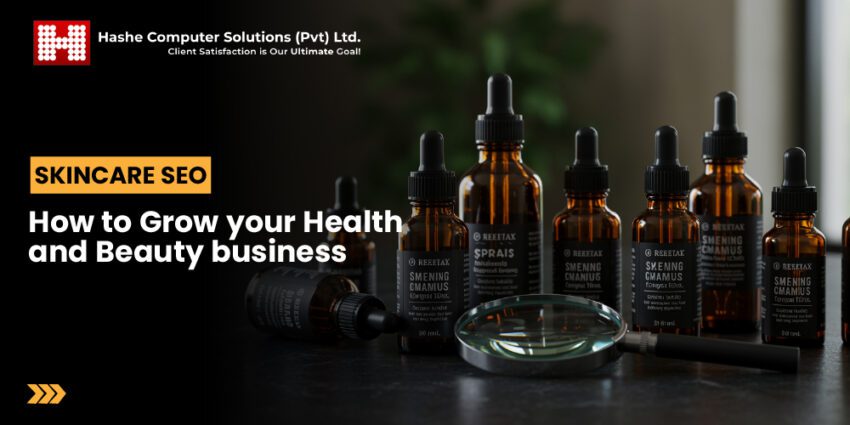
The beauty and wellness industry is evolving, and so is how people discover skincare products and services. Today, consumers turn to Google before visiting a spa, booking a facial, or purchasing a moisturizer. This shift makes Search Engine Optimization (SEO) more important than ever for skincare brands.
In this article, we’ll explore how Skincare SEO can help your brand rank higher, reach the right audience, and transform your digital presence into a powerful growth tool for your business.
Why Health and Beauty Brands Need SEO
In the health and beauty industry, first impressions matter, both on the skin and online. No matter how effective your skincare products are or how luxurious your spa treatments feel, they need to be visible to the right audience. That’s where skincare SEO becomes your ultimate beauty booster.
A strong SEO strategy is not just about ranking higher on search engines, but building trust, authority, and a loyal customer base. Here’s why it matters so much for skincare and beauty brands:
Enhanced Online Visibility
The skincare and beauty market is highly competitive, with new products and brands emerging every day. Effective SEO ensures your business stands out in search results, helping potential customers find you when they search for terms like “best moisturizer for sensitive skin” or “acne treatment near me.”
Improved visibility not only drives organic traffic but also positions your brand as a trusted and recognizable name within your niche.
Establishes Brand Credibility and Trust
Being at the top of search results communicates authority and reliability. Users tend to trust brands that Google recognizes as relevant and reputable. Through consistent SEO efforts, including quality content, trustworthy backlinks, and positive customer reviews, your business builds digital credibility that mirrors the trust of the customers.
Attracts High-Intent Customers
SEO helps your brand connect with audiences who are already interested in your products or services. These are consumers searching with intent, whether they are ready to purchase a new serum or looking for professional skincare advice. By optimizing your website for specific, relevant keywords, you attract qualified leads who are more likely to convert into paying customers, increasing both sales and ROI.
Delivers Sustainable and Long-Term Growth
SEO lays the groundwork for ongoing organic growth, unlike paid advertising, which ceases to provide traffic as soon as the budget is exhausted. With consistent optimization and quality content, your website can attract visitors month after month without relying solely on ad spend. This makes SEO one of the most cost-effective long-term marketing investments for beauty and wellness brands.
Improves User Experience
SEO is more than just ranking; it is also about providing a smooth and engaging online experience. A well-optimized website loads quickly, adapts to mobile devices, and gives clear, easy-to-navigate information. This enhances customer satisfaction, encourages repeat visits, and reflects the same level of care and attention that defines your skincare philosophy.
Strengthens Competitive Advantage
The beauty industry evolves rapidly, from new product trends to emerging search behaviors. Brands that prioritize SEO stay agile and visible, adapting quickly to what customers are looking for. A consistent SEO strategy helps your business remain relevant, authoritative, and competitive in a constantly changing marketplace.
Skincare SEO: Top Practices for the SEO Industry
Perform Keyword Research
In-depth keyword research entails finding and analyzing keywords relevant to your brand and niche that your target audience uses to find your company’s products.
The following steps can help you perform your keyword research.
Understand Your Audience
Knowing your audience is crucial before starting the keyword research. Conduct market research to identify demographics, skin concerns, preferences, pain points, and buying habits, to understand what consumers are searching for. This insight helps you choose keywords that align with their needs, ensuring your skincare brand attracts the right audience and builds genuine connections.
Make a List of Seed Keywords
Make a list of seed keywords for skincare, beauty, and associated product categories. Seed keywords are broad, basic terms that define your main products or services and serve as the starting point for keyword research.
In skincare SEO, examples include “skincare,” “acne treatment,” “moisturizer,” “anti-aging cream,” etc. These keywords help you discover more specific phrases like “best moisturizer for dry skin” and guide your overall SEO strategy.
You can evaluate the difficulty, competition, and search volume of selected keywords using keyword research tools like SEMrush, SEranking, Ahrefs, and Moz.
Research Long-Tail Keywords
Since long-tail phrases target specific audiences and can attract more customers, give them extra consideration.
Long-tail keywords are specific phrases such as “best serum for dry skin” or “natural acne treatment.” They are crucial in skincare SEO because they show clear intent, face less competition, and attract highly targeted visitors who are more likely to engage or make a purchase.
Analyze Competitor Keywords
Analyze your competitors’ websites to discover the keywords they are targeting. This way, you can gain significant information about the keywords that are generating traffic and conversions in your niche.
Additionally, observe which long-tail keywords your competitors are ranking for. These specific terms may have lower competition but higher conversion rates because they better align with user intent. For instance, if your competitor is targeting the long-tail keyword “best anti-aging serum for mature skin,” you could explore similar niche phrases to reach a focused audience.
Furthermore, if your competitors are running Google Ads campaigns, looking at their paid keywords can provide additional keyword possibilities.
Categorize Your Keywords
If your brand offers a variety of skincare products, organize your keywords by product category and specific skin concerns. For example, group terms related to “oil control,” “dark spot correction,” “sun protection,” “skin barrier repair,” “exfoliation,” and similar topics. This method enables you to target customers seeking specific solutions, enhancing the effectiveness of your SEO strategy.
Create a Mobile-Friendly
A mobile-friendly website provides a seamless user experience across all platforms, including smartphones, desktop computers, and tablets. It enables visitors to your website to navigate and explore your brand’s products and services effortlessly.
The following are the essential features of a mobile-friendly website.
- Fast Loading Speed & Responsive Design: Compressed images and videos, faster plugins, and responsive design will help your skincare website load quickly. Its text, layout, and graphics should automatically adjust to accommodate various devices and resolutions.
- Limited CTA: Your mobile website should be simple and not overloaded with complicated elements. Keep only a limited number of CTAs. Maintain sufficient whitespace on your website to help visitors understand your brand elements.
- Simple Navigation: Potential clients should easily access the necessary information and their preferred location. Ensure that users can navigate your site with ease and clarity.
- Reduced Pop-ups: Ensure that your mobile website does not have excessive pop-ups, as they may interfere with the user experience.
- Faster Customer Support: To make your website visitors’ shopping experience easier, provide them with a clear path and faster customer support. It should have a dedicated contact page, 24/7 chatbot support, and mobile live support.
Create High-Quality Content
Skincare consumers frequently seek information and answers. Inform them about different skin issues, product benefits, ingredients, and skincare practices with educational content.
High-quality content expands your audience reach, builds your brand as a reliable resource for beauty fans, and generates organic referral traffic to your website.
The following ideas can help you create quality content for your beauty and wellness brand.
- Guides and Tutorials: Make thorough yet easy-to-follow guides to instruct customers about how to use your beauty products and services. You can also create posts about cosmetics tips and tricks to build backlinks by showcasing your expertise.
- Infographics: Provide visually appealing and educational content. Make sure that infographics simplify complex skincare issues, presenting them clearly and concisely.
- Case Studies, Testimonials, and Success Stories: Customer feedback and user-generated content are two more ways to produce excellent content for your website. Customer testimonials and success stories showcasing your beauty brand’s products and services should be the focus of a dedicated page on your website. It helps you generate backlinks from existing clients to others who may find your company worthwhile.
- Expert Interviews and Roundups: Interview influencers and beauty specialists who can contribute their knowledge and experiences to create high-quality content for your brand.
Perform On-Page SEO
Enhancing the elements of your skincare website to increase its visibility on search engine results pages is known as on-page SEO. It entails improving your website’s relevance and accessibility for search engines and beauty enthusiasts.
When optimizing the on-page aspects of your skincare website, the following are the most critical factors to consider:
- Meta-Tags: Create captivating and relevant headings, subheadings, page names, and descriptions by effectively employing keywords. If you are optimizing a product page for a “Vitamin C Brightening Moisturizer,” for instance, make sure the title tag, meta description, and header all contain the keyword. Additionally, incorporate it organically into the product description.
- Internal Linking Structure: Effective use of internal links enhances the navigational structure of your beauty website. It also encourages visitors to stay on your website longer while they explore your company. For example, if your blog post is titled “How to Choose the Right Sunscreen for Your Skin Type,” make sure to link it to product pages that feature your range of sunscreens or SPF-based skincare products.
- Image Optimization: To optimize images on your website, compress them and add alt text. It enhances search relevance, user experience, and page speed.
- URL Structure: Ensure your web pages have SEO-friendly URLs that showcase the content’s value to both search engines and users. URLs should be brief and contain the primary keyword.
- Canonical URLs: In skincare SEO, canonical URLs help search engines identify the original or preferred version of a page when duplicate content exists, such as different versions of a product page. Using them correctly helps avoid confusion, keeps your site organized, and ensures your preferred page ranks higher in SERPs.
- XML Sitemap: To facilitate crawling, create and submit an XML sitemap to search engines. Search engine bots can easily find and access all of your website’s key pages if you have an XML sitemap in place. This ensures your most recent updates and content are indexed quickly, which will increase your exposure in search results.
- Schema Markup: Adding schema markup on your web pages will provide search engines with more information about your content. To improve your search results, apply schema markup to various website pages, such as FAQs, ratings, and product pages.
Acquire High-Quality Backlinks
Obtaining backlinks for a skincare company requires a comprehensive strategy that focuses on providing high-quality content, developing relationships, and advertising your brand within the beauty industry.
Here’s what you need to do:
- Create High-Quality Content: Generate beneficial and captivating content about common skincare issues, beauty tips, ingredient insights, and product reviews. High-quality content has a higher chance of being shared and linked to by other beauty-related websites.
- Reach Out to Beauty Bloggers and Influencers: Connect with influencers, skincare professionals, and beauty bloggers who have a sizable fan base in the beauty sector. Offer free skincare product samples in exchange for reviews, or work together to create skincare and beauty-related content.
- Do Guest Blogging: Take part in roundup blogs or listicles curated by beauty bloggers or industry media. These postings frequently highlight the best skin care cosmetics and beauty tips, as well as the expertise of professionals in the field. You can obtain valuable backlinks by being listed on reputable directories and industry-specific lists.
- Skincare Influencer Marketing: Collaborate with beauty influencers to market your skincare and makeup products. Influencers can post articles about your products on their blogs or social media accounts, resulting in backlinks and higher brand visibility.
- Sponsor Beauty Events and Workshops: Participate in workshops, beauty events, or charitable endeavors. Many event organizers put sponsor connections on their websites, allowing for backlinks from event-related pages.
- Participate in Beauty Forums and Communities: Participate in online communities and beauty forums about skincare and makeup. Offer insightful commentary and practical guidance, and when necessary, include links to relevant content on your website. This may result in organic backlinks from people in the community who find your work valuable.
Connect Social Media With Your Website
One of the most crucial strategies for raising your brand’s search engine results is social media. Ensure your company has a strong social media presence to dominate the beauty market and rank higher in search engine results.
The following strategies will help you improve the social media performance of your skincare brand:
- To improve the visual appeal for your customers, include icons from popular social media platforms beside your social profile links.
- Provide excellent, helpful information on your social media accounts, such as product reviews, beauty tips, tutorials, and hacks, in a way that keeps your followers engaged.
- Messages, comments, mentions, expert podcasts, live sessions, Q&As, and other interactive elements can all help you communicate with your audience.
- Integrate live social media feeds into your website to highlight your active social media presence. Real-time displays of your most recent posts or client interactions can enhance your website’s dynamic content and entice visitors to follow you on social media.
- Utilize photo-sharing platforms such as Facebook, Instagram, and Pinterest to provide shareable product tutorials, instructive infographics, and transformation photos.
- Display client testimonials and social proof on your website. To gain the trust and credibility of potential clients, highlight good reviews and comments on social media.
- Cooperate with top beauty professionals to produce content. In addition to boosting brand awareness, this makes your business reputable in the beauty industry.
- Use your social media channels to promote the information on your website and vice versa. Encourage your social media followers to visit your website by sharing links to brand-new blog entries, product debuts, or exclusive deals.
Promote User-Generated Skincare Content
The content that your audiences and customers provide about products based on their interactions and experiences with your brand is known as user-generated content. It can take many different forms, such as social media stories, skincare routines, product evaluations, and testimonials.
The following are the best tactics to promote user-generated content for higher SERP rankings:
- Ask your existing customers to write reviews and collect testimonials for your website and social media accounts to help you rate your brand.
- To promote your beauty business to a worldwide audience, create hashtags using brand-relevant keywords. Request that customers of your product use a specific hashtag when sharing brand-related content. It helps raise your brand’s level of engagement.
- Run giveaways and beauty contests across various marketing platforms to encourage people to submit content about your business in exchange for benefits and incentives.
- To demonstrate your legitimacy to potential clients, highlight your social media handles with customer transformation stories, reviews, and endorsements.
- Share user-generated content (UGC) that positively portrays your products. Create a feeling of community by tagging and acknowledging your customers’ work in your posts.
- Work with industry influencers and social media makers to develop user-generated content that promotes your cosmetic products and services. This step encourages more and more people to contribute to your marketing campaigns and produce content that mentions your business.
- Encourage clients to share their skin-care transformation stories. Emphasize how your items have improved their confidence and skin health. These genuine experiences resonate with potential clients who may be dealing with similar skincare concerns.
Conclusion
In today’s competitive online-driven beauty world, a strong skincare SEO strategy is key to helping your brand stand out and connect with the right audience. By understanding your customers, using targeted keywords, and optimizing your website content, you make it easier for people to find and trust your products. SEO is not a one-time effort; rather, it is an ongoing process that builds your brand’s visibility, credibility, and long-term success. With the right approach, your skincare business can grow naturally and shine in an increasingly competitive market.
Are you looking for the best IT providers for your IT projects? Look no further than Hashe! Hashe Computer Solutions is a leading IT solutions provider that offers world-class software, mobile application, web development, and digital marketing services. Contact us for the best web design solutions!
Was this helpful?
Last Modified: October 24, 2025 at 3:42 pm
38 views















